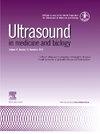EfficientNet-Based Attention Residual U-Net With Guided Loss for Breast Tumor Segmentation in Ultrasound Images
IF 2.4
3区 医学
Q2 ACOUSTICS
引用次数: 0
Abstract
Objective
Breast cancer poses a major health concern for women globally. Effective segmentation of breast tumors for ultrasound images is crucial for early diagnosis and treatment. Conventional convolutional neural networks have shown promising results in this domain but face challenges due to image complexities and are computationally expensive, limiting their practical application in real-time clinical settings.
Methods
We propose Eff-AResUNet-GL, a segmentation model using EfficienetNet-B3 as the encoder. This design integrates attention gates in skip connections to focus on significant features and residual blocks in the decoder to retain details and reduce gradient loss. Additionally, guided loss functions are applied at each decoder layer to generate better features, subsequently improving segmentation accuracy.
Results
Experimental results on BUSIS and Dataset B demonstrate that Eff-AResUNet-GL achieves superior performance and computational efficiency compared to state-of-the-art models, showing robustness in handling complex breast ultrasound images.
Conclusion
Eff-AResUNet-GL offers a practical, high-performing solution for breast tumor segmentation, demonstrating potential clinical through improved segmentation accuracy and efficiency.
基于高效网的关注残差u -网的乳腺超声图像肿瘤分割。
目的:乳腺癌是全球妇女的一个主要健康问题。乳腺肿瘤超声图像的有效分割对于早期诊断和治疗至关重要。传统的卷积神经网络在这一领域显示出了很好的结果,但由于图像复杂性和计算成本高,限制了它们在实时临床环境中的实际应用。方法:提出effe - aresunet - gl分割模型,采用effenetnet - b3作为编码器。本设计在跳过连接中集成了注意门,以关注重要特征和解码器中的残余块,以保留细节并减少梯度损失。此外,在每个解码器层上应用引导损失函数来生成更好的特征,从而提高分割精度。结果:在BUSIS和数据集B上的实验结果表明,与最先进的模型相比,ef - aresunet - gl具有卓越的性能和计算效率,在处理复杂的乳房超声图像方面表现出鲁棒性。结论:Eff-AResUNet-GL为乳腺肿瘤分割提供了一种实用、高性能的解决方案,通过提高分割的准确性和效率,展现了临床应用的潜力。
本文章由计算机程序翻译,如有差异,请以英文原文为准。
求助全文
约1分钟内获得全文
求助全文
来源期刊
CiteScore
6.20
自引率
6.90%
发文量
325
审稿时长
70 days
期刊介绍:
Ultrasound in Medicine and Biology is the official journal of the World Federation for Ultrasound in Medicine and Biology. The journal publishes original contributions that demonstrate a novel application of an existing ultrasound technology in clinical diagnostic, interventional and therapeutic applications, new and improved clinical techniques, the physics, engineering and technology of ultrasound in medicine and biology, and the interactions between ultrasound and biological systems, including bioeffects. Papers that simply utilize standard diagnostic ultrasound as a measuring tool will be considered out of scope. Extended critical reviews of subjects of contemporary interest in the field are also published, in addition to occasional editorial articles, clinical and technical notes, book reviews, letters to the editor and a calendar of forthcoming meetings. It is the aim of the journal fully to meet the information and publication requirements of the clinicians, scientists, engineers and other professionals who constitute the biomedical ultrasonic community.

 求助内容:
求助内容: 应助结果提醒方式:
应助结果提醒方式:


